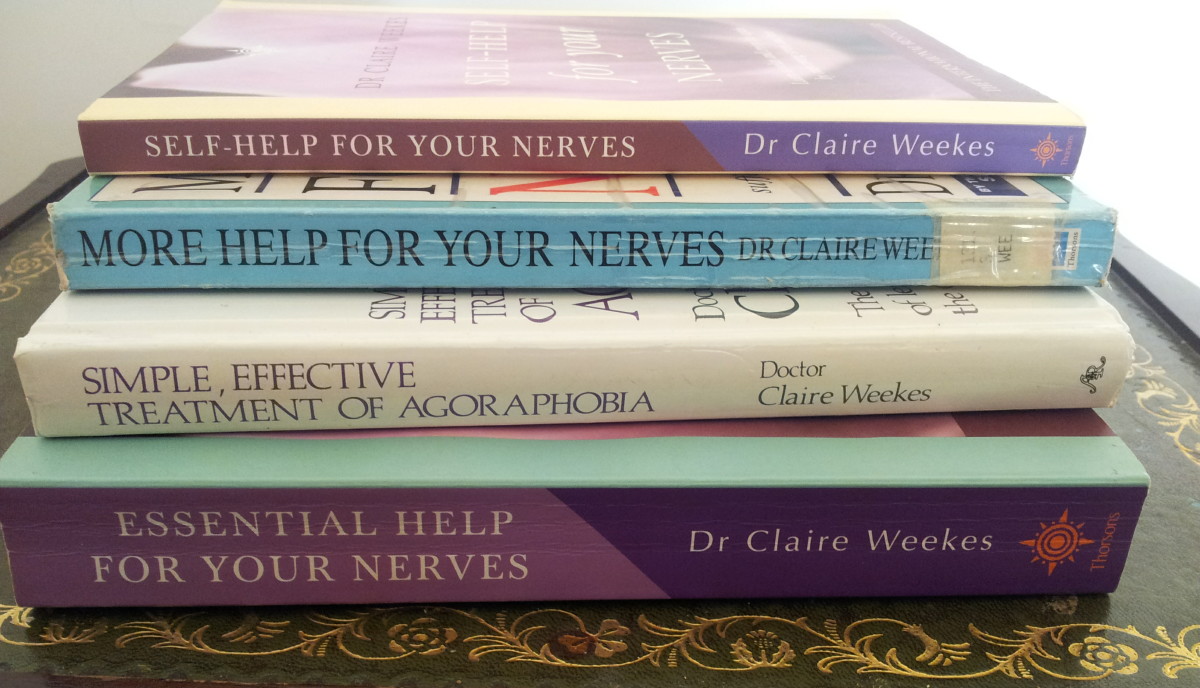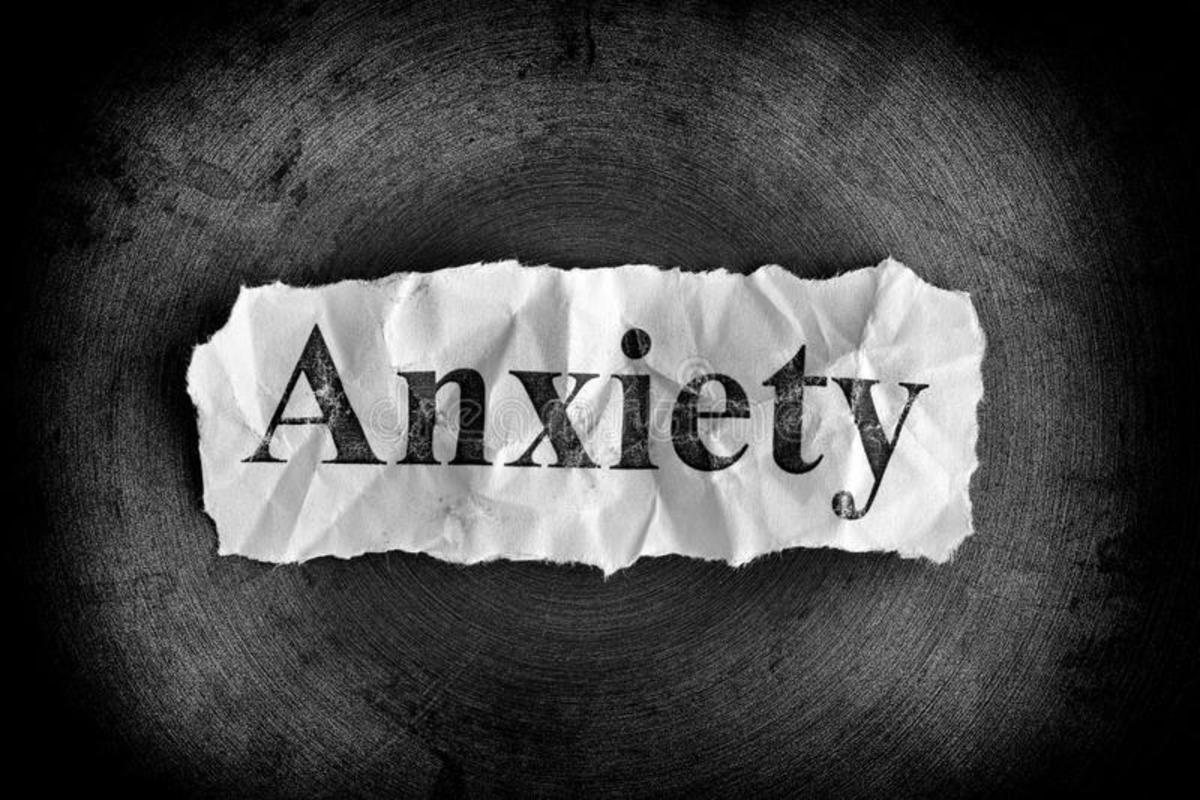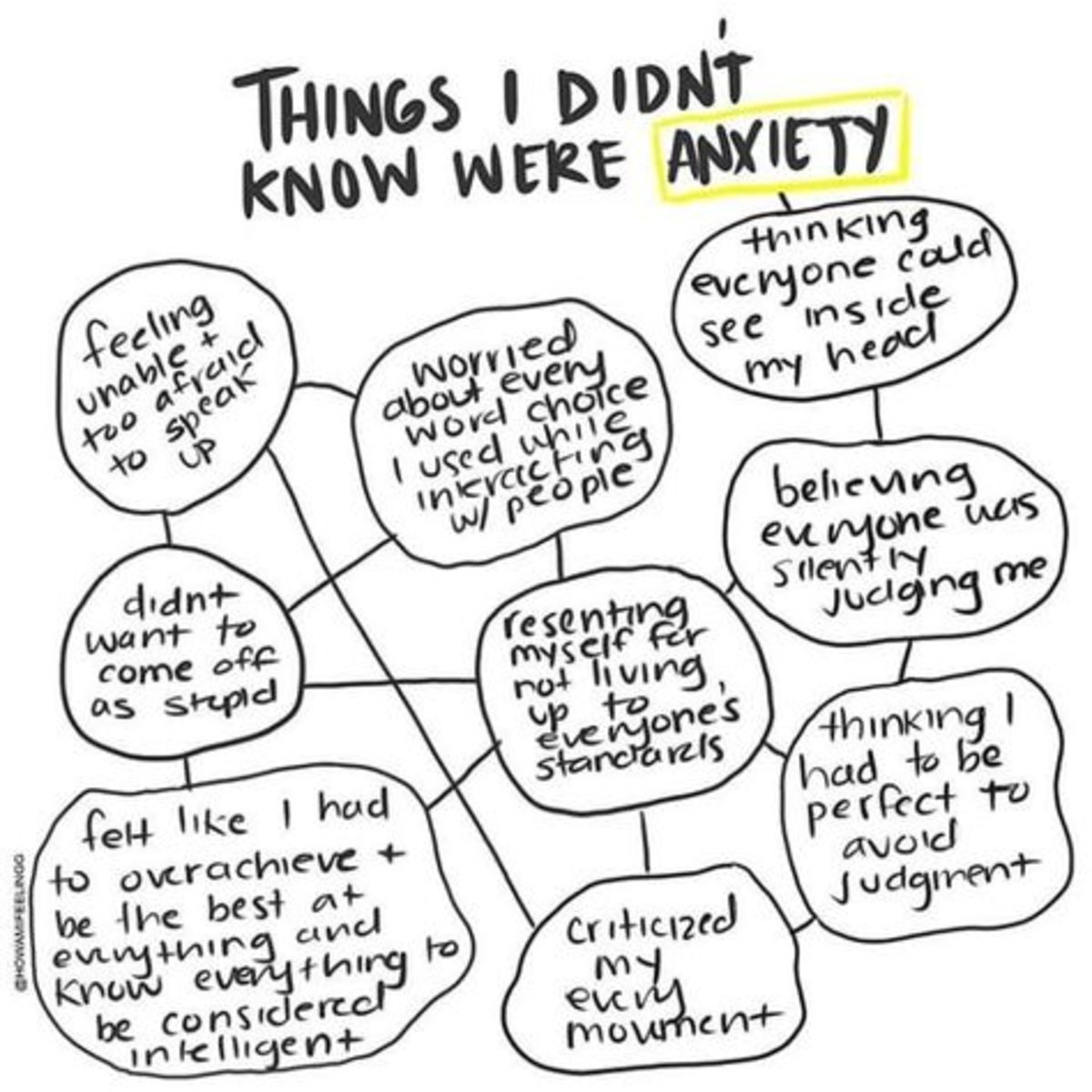- HubPages»
- Health»
- Mental Health»
- Anxiety Disorders
Is Selective Mutism an Anxiety Disorder?
Anstendig, Karin D.(1999). Is Selective Mutism an Anxiety Disorder? Rethinking Its DSM – IV Classification. Journal of Anxiety Disorders, 13(4), pp. 417 – 434.
Doctor of Psychology, Karin Anstendig, introduces the characteristics of the selective mutism disorder. Furthermore, she explains through relevant traits, if it can be classed as an anxiety disorder. The article provides us with information about the psychological and the physical features of children with selective mutism disorder and also with factors which affect and contributes to the evolution of this specific disorder. The children with this disorder, are about the 1% of the population and have certain symptoms. Such as, withholding speech in social situations, for example in the school. Also, shyness, language abnormalities, hesitating behavior and insecurity. Gender probably plays a role. Post traumatic stress can also be a contributor. Biological and genetic factors also have been associated. The selective mutism, tends to affect more females rather than males. These are some of the characteristics that the article provide us. However, the author emphasizes the fact that lots of the family and environmental influences can cause this kind of disorder. Probably as well, as the DSM – IV supports, it could be also a disorder of the infancy, the adolescence and finally the childhood. These children have an intense fear for unknown people and situations, as well. The structure and the relations within the family, play a very important role in the personality of the children. A lot of times there is a member in the family who suffers from symptoms similar with the selective disorder or with this specific disorder. An other critical symptom is the mother – child overenmeshment and inderdependence. Over the years, have been conducting several studies and methods of therapy on such rare disorder that attach the consequences and other of the aforementioned factors, such as behavioral interventions, symbolic play and psychopharmacological treatment with antidepressant drugs, (fluoxetine and phenelzine). According to Karin Anstendig, the DSM – IV classification of the selective mutism disorder as a another disorder of adolescence, childhood or infancy is under questioning. She better prefers classifying the selective mutism disorder to the anxiety disorder category or as a symptom of a specific anxiety disorder. The investigation of the author, can be considered as sufficiently detailed and provide us with all the needed information. Nevertheless, the research does not supplying us with enough research and still remains a controversy to the classification of the selective mutism. It is needed newer studies, so as to become clearer the DSM – IV classification rethinking.
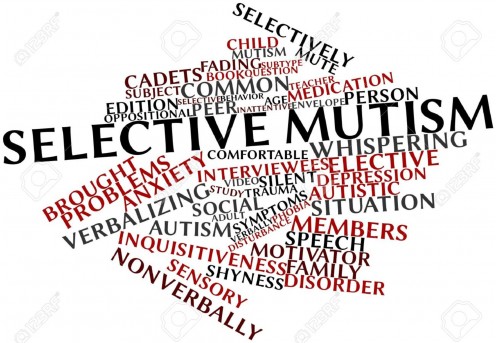
“I have packed myself into silence so deeply and for so long that I can never unpack myself using words. When I speak, I only pack myself a little differently.”
— Herta Müller, The Hunger AngelMuris Peter & Ollendick Thomas H. (2015). Children Who are Anxious in Silence: A Review on Selective Mutism, the New Anxiety Disorder in DSM – 5. Clinical Chil
Psycologists Muris Peter and Ollendick Thomas, provide us with all the necessary elements, in order to be able to understand if the selective mutism disorder is included in the anxiety disorders. Specifically, to the etiologies of the disorder, in treatment methods and also at the evolution of the classification of the selective mutism in the DMS. The article refers to the selective mutism disorder as a rare childhood disorder, where the diagnosis is made in the first month of the symptoms and is more common in girls than in boys. The symptoms which are included in this particular disorder are the low frequency of the words, the shyness, less spontaneity. Also some children are more difficult to handle, because they do not want to follow the rules of their family, the lower level in the social interaction and the delay in their development. The etiologies of the selective mutism disorder come from genetics, family issues, also environmental, temperamental and neurodevelopmental, as well. A lot of times, members in the family tend to suffer from this specific disorder or other disorders. Very important etiology, is also the background of the family. Selective mutism, as the authors have written, also is a symptom after a sexual abuse or divorce. Also, if the family where the kid belongs are immigrants, or are very controlling and overprotected. As for the neurodevelopmental factors, the phonological or the expressive language disorder play a very important role in the development of the selective mutism. The treatment includes, psychosocial intervention,such as cognitive – behavioral, social skills training model, pharmacotherapy (SSRI, MAO, phenelzine). The DSM – 5 has the selective mutism among anxiety disorders. In the past it is known as ''voluntary aphasia'' and later as ''elective mutism'' in the DSM – 4. The authors explain about similarities with other anxiety disorders, but, they focus more on the social phobia. DSM – 5 categorize the selective mutism as a separate anxiety disorder. To conclude, as such the authors noted, there are gaps in their research and they suggest more treatments which combine the cognitive – behavioral and the pharmacotherapy and the multimodal treatment packages which will help also the parents of the child. Their research on the topic, was fairly detailed, however they had to include other elements for the assessment of selective mutism as a kind of anxiety disorder as it is defined in the DSM – 5.
“Destiny is not always preordained. Life is about making choices. Our lives are the sum of all the choices we make, the bridges we cross, and the ones we burn. Our souls cast long shadows over many people, even after we are gone. Fate, luck, and Providence are the consequence of our freedom of choice, not the determinants. When justice is served by following our principles, making good decisions brings us inner peace.”
— Judith Land, Adoption Detective: Memoir of an Adopted ChildOmdal Heidi & Galloway David (2007). Interviews with selective mute children. Emotional and Behavioural Difficulties, 12(3), pp. 205 – 214.
The authors provide us with information about the children with selective mutism disorder who gave interviews and also they analyze their behavior through the Raven's Controlled Projection for Children (RCPC) and its results. The article explains, that is very difficult for the children to express themselves to a clinic by talking about their sensitive issues, such as their inner thoughts. The children with this specific disorder, refuse to speak in public. Nevertheless, they do not experience any problem in the communication within the family (American Psychiatric Association, 1994). So, the method of the Raven's Controlled Projection for Children according to the experts, is the best way to help the children with selective mutism, to open up about their private lives, in the house and out of it, as well. This technique is carried out in group rooms at the school. The methodology of this technique, gives the chance to the children to express themselves by writing and/or using a computer. The data which the clinicians need from the children, in order to help them, is their relationship with their family and the relations between family members. Also, the friendships, the relationship with other adults, their fears and fantasies. If there is experience with sexual abuse, the anxiety about their parents, health and death. Furthermore, about problems making friends, the jokes, the lies, the school refusal, the drugs and alcohol and so on. The results of this technique were absolutely the expected ones. The children responded to this specific technique, with the writing, the use of the computer and through paintings. They expressed their inner world without much difficulty. Over the years, had been conducting many studies on stubbornness, the determination and the social anxiety. Unfortunately, there were only a few treatment case studies which took serious the selective mutism disorder, so as to be find the correct treatment. There were only two major tasks so as to understand the ''world of the child''. With the use of the Raven's Controlled Projection for Children (RCPC), the results were very clear. The article could indicate more information to the reader on selective mutism disorder. However, it only focus on children's results. The article was not fully responded to the expected outcomes of the initial question about whether this particular disorder is related to anxiety disorders. Also, no special analysis was made for the disorder for which, some interviews of children with selective mutism disorder were conducted.
Characteristics
| of
| Selective Mutism
|
|---|---|---|
Temperamental Inhibition
| Social Anxiety Symptoms
| Social Being
|
Physical Symptoms
| Appearance
| Emotional
|
Developmental Delays
| Sensory Integration Dysfunction (DSI) symptoms, Processing Difficulties/Delays
| Common symptoms
|
Communication Difficulties
| Social Engagement Difficulties
| Co-Morbid Anxieties
|
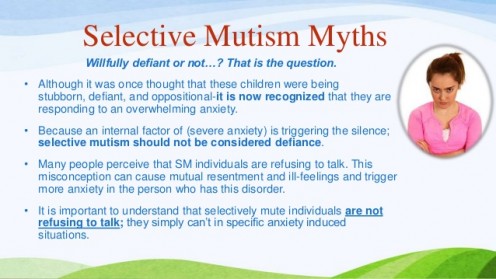
“Aloneness – that is what SM feels like to me. Isolated, alone, separated, left out as I silently stand by watching others experience life while the words freeze inside me, afraid to speak up or join in a conversation. Actually feeling the anxiety shaking inside my chest as I try to get up the courage to speak to someone or call or text a friend. SM feels like the child standing alone behind the door watching the other kids in the playground – afraid to ask, 'may I play?' It feels like the teen
— Carl Sutton, Selective Mutism In Our Own Words: Experiences in Childhood and AdulthoodPonzurick Joan M. (2012). Selective Mutism: A Team Approach to Assessment and Treatment in the School Setting. The Journal of School Nursing, 28(1), pp. 31 – 37
Ponzurick Joan, explains all the characteristics of the children with the selective mutism disorder and the importance of the role of the nurse at schools. The author explains, that the children with the selective mutism disorder have extreme shyness, fearfulness, controlling or oppositional behavior, social isolation and developmental delay. The selective mutism, according to the psychodynamic theorists can be caused as a result of unresolved conflict with the parents and physical or psychological trauma, as well. Furthermore, according to the behavioral theorists, as a negatively reinforced learned behavior. The anxiety also is a factor which can cause the selective mutism. Another basic and characteristic opinion of the psychodynamic theorists is that this specific disorder, is a way of punishment to the parents from the children, probably anger and also anxiety. The article focuses in the treatments of selective mutism disorder and especially in the nursing for selective mutism disorder at the schools. The nurse at the school, is a member of the Instructional Support Team (IST) and the role is to provide communication between the parents, the school staff and the medical group. The role of the nurse according to the article, has the most success of any other treatment. Other treatments, are the positive reinforcement, the graded real – life exposures, the systematic desensitization, the pharmacotherapy (SSRI). Another very useful treatment is the team approach treatment at the school and the interventions in the classroom. According to DSM the selective mutism was first an inability to speak. The name of the disorder was ''aphasia voluntaria'' and later as ''elective mutism''. In the 80's the DSM categorized the disorder as a separate clinical diagnosis and not a communication disorder. In 1994 the name changed to ''selective mutism''. In 2000 the DSM classified the disorder to '' disorders of infancy, childhood or adolescence''. Τhe author focuses more on the ways of dealing with the specific disorder and not with the ranking of it. However, the author proposes the detection and therapy of the disorder, as soon as possible and also the existence of the education for teachers for the medical issues, so as to help the children not to develop psychological issues. Nevertheless, it is very clear the classification of the DSM. The author's research was not so comprehensive and does not focus on the main subject which is investigated by me, the classification of the disorder as an anxiety disorder
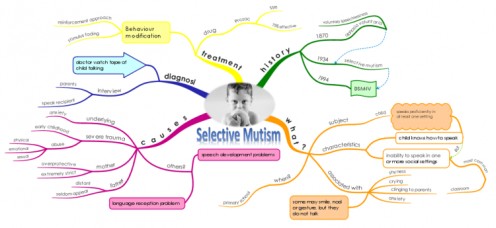
Sharp W. G., Sherman C. & Gross Alan M. (2007). Selective Mutism and Axiety: A review of the current conceptualization of the disorder. Journal of Anxiety Disor
The authors analyze the symptoms of the selective mutism disorder at children, the etiologies, the treatments, the DSM classification of the disorder and finally, their opinion. The selective mutism disorder has been associated with a lot of childhood psychiatric conditions. This specific disorder can be categorized as an anxiety – related condition. According to DSM – IV criteria, the selective mutism is not a result of lack of knowledge or an organic inability to understand the language. It is supposed to exists in social situations, in education and with unknown people. It is more among girls and the diagnosis is visible at least at 1 month. In adults this disorder is rare. Children with selective mutism, struggle with shyness, behavioral inhibition, poor eye – contact, reticence, slow – to warn tamperament, co – occurs with a number of anxiety – related conditions. Additionally, with high prevalence of language – speech and developmental problems. The article inform us that in 1877, the selective mutism was documenting in the condition where people didn't speak in specific situations. That period the disorder tended to be called ''aphasia voluntaria''. DSM also suggested, that the disorder, does not occur during serious disorders such as pervasive development disorder, schizophrenia or other psychotic disorder. The diagnosis of the selective mutism also does not exclude other types of communication, such as shaking head, gesturing and pulling or pushing. To continue, a lot of studies have attributed the selective mutism disorder to a lot of etiologies. Family dysfunction, neurodevelopmental problems, chilldhood social phobia, oppositional behavior or social anxiety. Many early clinicians have asserted that the children do not want to speak, because of an esoteric desire to manipulate their family and the environment. However, this point of view, lacks evidence. Selective mutism disorder and anxiety disorder are related in a large proportion. On the other hand, selective mutism can be a subtype or a precursor of the social phobia, but they both differ at the age (SP=10 years and SM=5 years). The treatment for this disorder, is the same with this of the anxiety disorders. Most remarkably are the behavioral approaches such as stimulus fading, systematic desensitization and reinforcement and pharmacotherapy. Τhe authors propose more research on this rare disorder, in all of its manifestations. They authors are not so clear about the classification of the selective disorder, and also they have limited data and lack of strong elements.
© 2018 Chrysi Stamou

